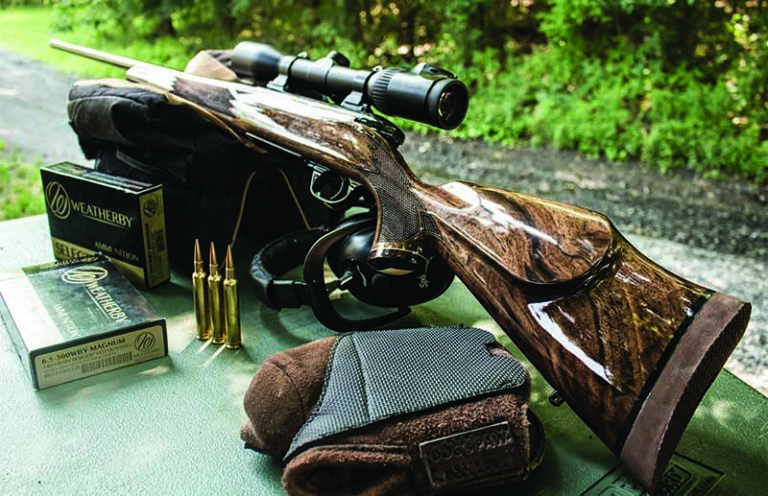
How the construction and conformation of your rifle stock changes everything downrange.
What Are The Important Points On Rifle Stock Fit:
- The comb on most modern stocks' combs are too low to constantly align the eye with a scope.
- Low combs are preferred on rifles with iron sights or ones that use both irons and scopes.
- LOP typically runs too short on production rifles, leading to more felt recoil and having to “scrunch” to fit the rifle.
- Too long, however, and the rifle can be slower to mount, hanging up on clothing among other things.
- Grip designs and comb designs have become thicker, thus make a full grip more difficult.
- This is fine for small bores and precision shooting, but with heavy calibers sacrifices control.
I was on an African hunt with a .404 Jeffery set up over shooting sticks with a wildebeest bull nearly 200 yards away. My PH, Cornus du Plooy, gave the green light. I broke the trigger, heard the bullet’s impact and, after recoil, saw the bull fall. “It’s a good rifle, that,” Cornus commented. He certainly wasn’t wrong.
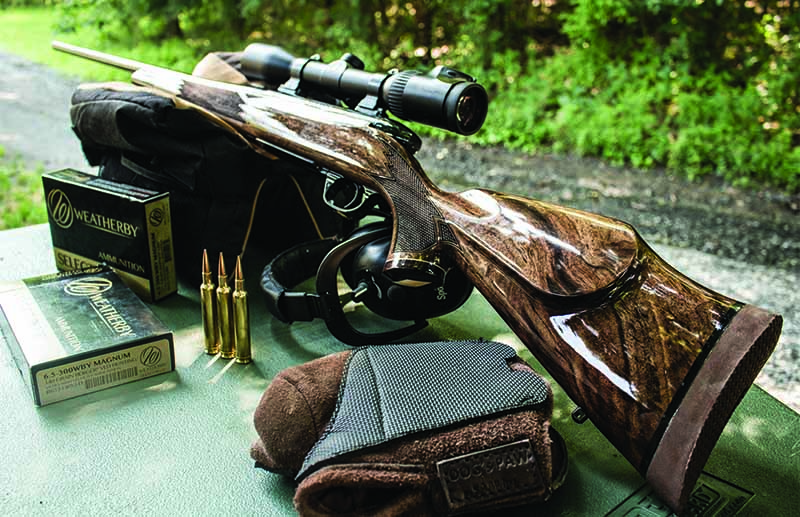
That particular rifle—a Heym Express by Martini—was stocked perfectly for my frame. The Express’ stock is designed by famed gunsmith Ralf Martini, and that’s among my favorite stock designs ever produced. After that first experience with that .404 Jeffery, I got to thinking long and hard about what makes a proper rifle stock.
I admit that, until I held some of the finer British and European rifles, I was woefully ignorant as to the effects of stock fit. There are good features in all designs—but equally many flaws. I’ve my own favorites, and there are some I just don’t like … or perhaps they just don’t fit me well.
At any rate, I started a correspondence with some folks very familiar with stock design, to gather their thoughts. Chris Sells is president of HeymUSA and passionate about vintage-style double rifles and bolt-action guns, as well as embracing modern actions like his straight-pull. Mark Bansner is the head of Bansner & Company LLC, a custom rifle company; he’s as famous for his rifles as he is his synthetic stocks. I also chatted with Zack Buck of Blak Forge Armoury. He’s passionate about classic stock designs of vintage firearms, including traditional muzzleloaders, and is well-versed in making replacement stocks for vintage firearms of all sorts.
Comb Height And Riflescopes
Looking at the way stocks have evolved over the past century, we’ve seen a change in sighting systems, with the telescopic sight playing a much larger role. However, the combs of modern stocks—both walnut and synthetic—don’t seem to have followed suit. I’ve made several trips to the SAAM Shooting School at the FTW Ranch in Barksdale, Texas, where highly talented instructors push you to give your best. They add a cheek pad to almost every rifle they handle, to better align the shooter’s eye with their optic and give proper cheek weld. Apparently, I’m not alone in feeling the average comb is too low.
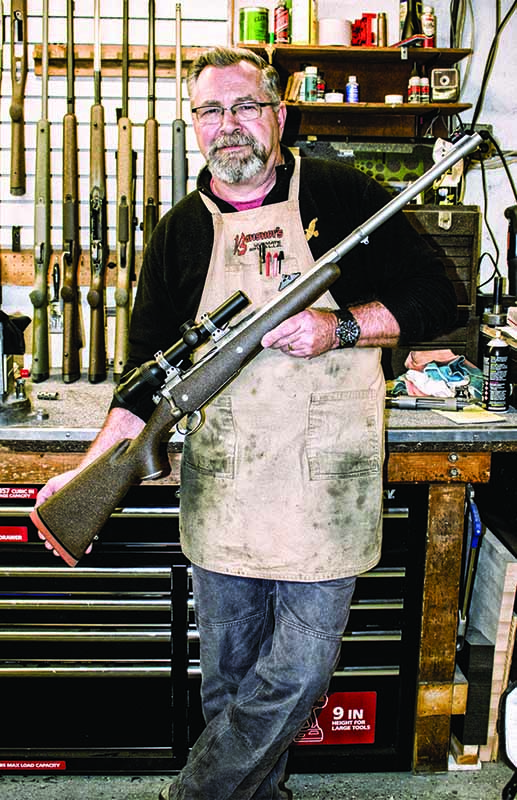
“Most rifles today have a comb height too low for proper fit when scoped,” said Bansner. “Cheek weld allows you to place your face on the stock at the same location with the same pressure to use the scope effectively. When building a stock from wood or synthetic, it’s important to keep the comb as high as possible to get this cheek weld. However, there’s one issue that pops up: On long-action bolt rifles, and even some shorts, the bolt hits the stock when cycling the action. On some of today’s tactical stocks, they make the comb very high and cut a notch in the nose of the comb to allow for bolt clearance and removal. While fine on a tactical gun, it looks bad on an English walnut stock. Many folks are adding a lace-on comb height pad to help with this issue on sporting stocks.”
Buck is also well aware: “I shape my combs to fit the height for the primary intended use of the rifle. On a scoped rifle, that means higher combs; as a rule, though, I try and keep the scope as low as I possibly can. This allows a lower comb, and I feel, better aesthetics, and gentler perceived recoil.
“Factory Monte Carlo-style combs are an easy solution to a ‘one-size-fits-all’ problem,” added Buck. “The forward-slanting comb line allows for ‘good enough’ cheek weld with a variety of scope heights and shooting styles. There has been a trend recently to use larger scopes, both in magnification and in tube diameter. This pushes the center of the scope higher—often higher than a stock was designed for. When fitting a customer for a new rifle stock, the comb height will be a bit different if they choose a 3-9x in a 1-inch tube versus a 34mm tube. The middle of the scope is nearly 5/32-inch higher in the 34mm tube.”
Combs And Hard Irons
While having your comb at the proper height for an optic is great if you use nothing but optics, what about those rifles that routinely use both scopes and iron sights? I’m speaking mainly of the big-bore rifles used for dangerous game hunting, which might be required to make a 150- or 200-yard shot, then have the optic removed for close-quarter follow-up work. In this instance, the only choice is to stock the rifle for the lower iron sights and compensate for the scope.
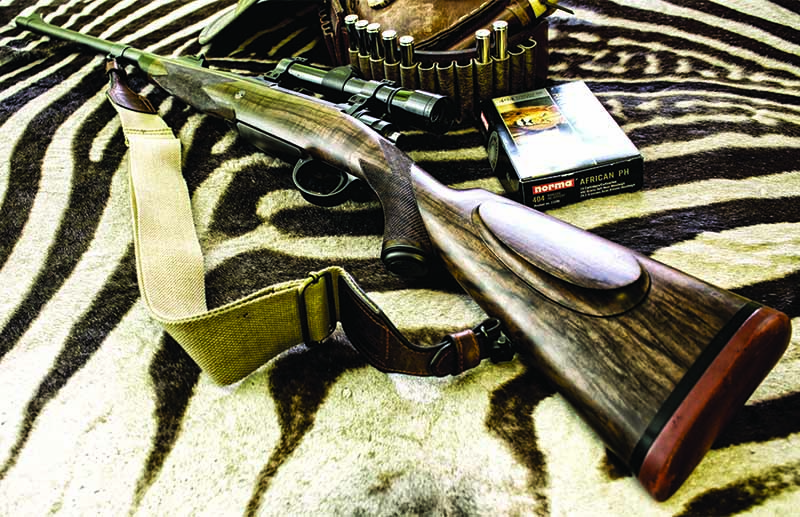
“The high comb of the Weatherby stock is probably the best at lining the shooter’s eye up with the scope, but it does limit use of the rifle to scopes only,” said HeymUSA’s Sells. “This is not an option for our dangerous game rifles. They must be stocked in such a manner as to make them functional with open sights. At the same time, most of our shooters like to use a scope when possible, so there’s always a balancing act when trying to accommodate both. Having said that, a dangerous game rifle equipped with a scope and no open sights is only half of a rifle.”
The proper cheek weld is also the key to reducing felt recoil. All three guys agreed that improper cheek weld can result in that awful slap in the face, especially from the bench. Get the head aligned properly, and perceived recoil is immediately mitigated.
Learn More About Rifle Stocks:
- Mosin-Nagant Stocks: Upgrade Your Warhorse
- Do Carbon-Fiber Stocks And Barrels Live Up To The Hype?
- Boyds Spike Camp: Drop-In Stock Test
- Laying The Wood: The Story Of Laminate Stocks
- How-To: Block Bedding Synthetic-Stock Rifles
- Read More on Fine Custom Rifle Stocks
Locking In The Length
Length of pull (LOP) is also an attribute that many American rifles don’t get right—I’m usually hunched over when shooting the standard 13¾-inch length of pull. At just a shade under 6 feet tall, with long arms for my frame, I prefer a longer stock. If I’m wearing a heavier hunting jacket, I like a 14-inch LOP. In just a shirt, I like 14⅜ inches and a tad longer in a double rifle.
“I think this is a function of mass-producing a gun that ‘sort of’ fits everyone,” added Buck. “It’s easier to scrunch up on a gun that’s too short than it is to reach on a long gun. The other reason is in shooting style. It appears to me that Europeans still point their rifles more out to the front, while Americans seem to keep the rifles tighter to their chests. I also suspect that the habit of shooting from a seated position, or even off of a rail by Americans, has also mitigated some of the ‘short’ feeling from shorter LOPs.”

“Length of pull is a very tricky measurement,” said Bansner. “Some of the old methods of taking a measurement are not very reliable. People’s arms are all different lengths. Height, weight and arm length all come into play for this measurement. Length of pull is far more critical on shotguns than on rifles. For most shotgunning, your eye acts as your rear sight.
“The average LOP on U.S.-made rifles is about 13½ inches, and on shotguns it’s 14 inches,” added Bansner. “European makers do extend the LOP ½- to ¾-inch longer on most of the long-guns they produce. The proper way to fit a stock to a client is with a try stock. These are adjustable in every way possible and, in some cases, are shootable. The LOP is important when mounting a long-gun quickly in a hunting situation. Too long and it will hang up on clothing. On a scoped rifle, getting proper eye relief is very important. It will keep the scope from splitting your head open.
“I have a formula I use for scoped rifles,” Bansner continued. “A shooter 5 feet, 9 inches tall and weighing 180 pounds, should be around 13½ inches with their LOP; for every inch of height above or below, add or subtract 1/8 inch. This works for average weight people; you have to adjust for heavier folks, making it shorter for sure.”
Sells uses a similar formula, recognizing the importance of having a proper length of stock. Dealing with some hard-kicking rifles, Sells’ theory is to keep the shooter’s thumb away from their nose. He measures his clients much like a tailor does, and the Heym formula certainly works.
Agreeing On Grip
While all three of these men take great pride in their own stock designs, I asked them which of the popular rifle stock designs appealed to them most. All agreed the Winchester Model 70 is a classic design, and probably that which is the most appealing. Bansner also appreciated the older Ruger M77.
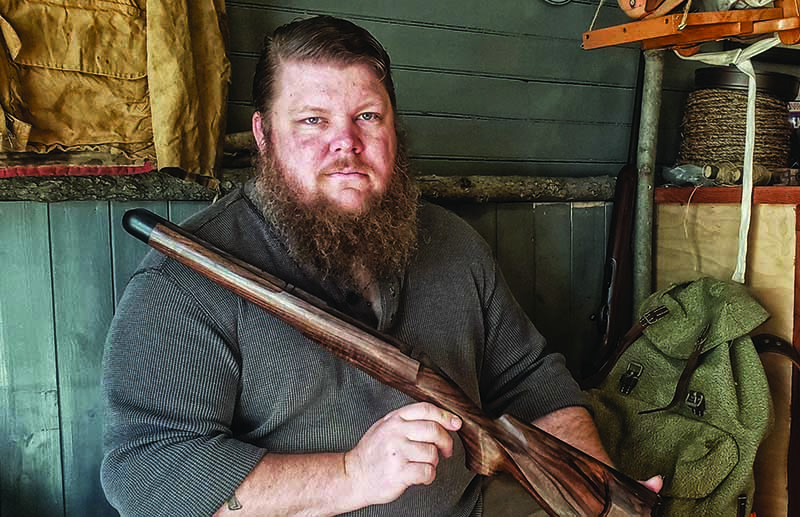
We also discussed the recent trend of keeping the trigger-hand thumb on the right side of the rifle. I’m not a fan of the technique, although I recognize that it does have its place. I’ve seen some stock designs where the nose of the comb is made in a manner that prevents a traditional grip—the Nosler M48, for example—and asked for thoughts and opinions on that design.
“I believe the reason for this trend is several-fold,” said Buck. “First, it’s brought in from the military. When I was teaching Basic Rifle Marksmanship, one of the tools we used to help soldiers from pulling their shot was to keep the trigger-hand thumb on the back of the grip and curl their fingers and put them on the front of the pistol grip—in essence not holding onto the rifle with their trigger hand at all. Now, this has very little to do with traditional hunting rifles, but it might just be transitioning habits from one platform to another.
“I’m not in support of shooting a hunting rifle like a long-range bench gun or sniper rifle, or even a rifle designed to be fired primarily from the prone for varmints,” added Buck. “I feel there’s also a push for conservation of movement, and wrapping the thumb back over the stock after actuating the safety is an ‘unnecessary expenditure of energy’ under that philosophy. Another cause is that too many mass-produced stocks have too thick of a comb nose. This can be uncomfortable to wrap your thumb around. Comfort of the thumb when crossed over is one of the things I ensure when fitting a rifle stock. While I build bespoke stocks, I build them to fit the customer, not bad habits. I like to make sure the thumb can cross over, and the cheek and head are in the right position.”
Bansner has a differing opinion than I do for the right-side-thumb grip.
“I’ve been using this style for years now and for good reason,” Bansner explained. “There are many ways to hold a rifle when shooting; some have a major effect on performance. The death grip will transfer every heartbeat and breath into the rifle. Keeping your thumb on the trigger-finger side will minimize the pulse transferred to the stock. It also keeps your trigger finger more relaxed. This is my preferred method when shooting from a bench for accuracy: three fingers on the pistol grip with pressure to the rear into your shoulder and the thumb on the trigger finger side.”
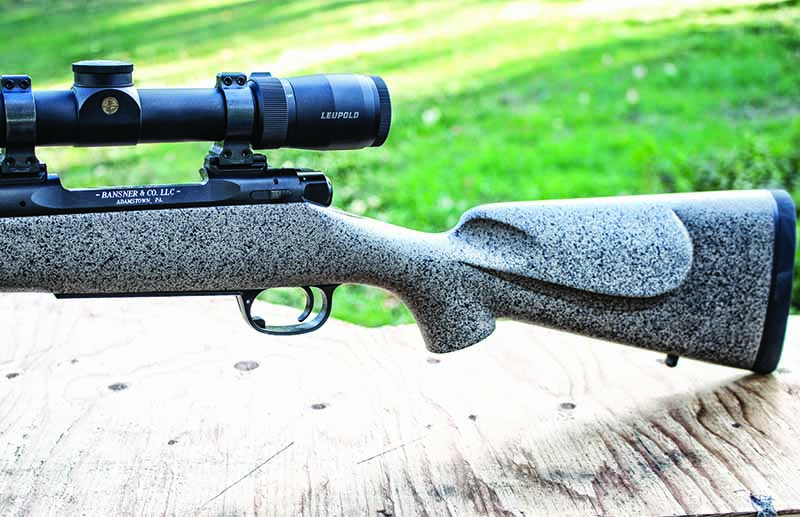
I can see it for lighter-recoiling rifles, but I will respectfully maintain my position when it comes to the heavier cartridges. Sells also felt the same way: “On a heavy kicking rifle, a firm grip with your trigger hand is essential. It might be trendy when shooting small bores, but I can assure you that no one is shooting a .375 H&H without a firm grip.”
Wood Vs. Not Wood
Lastly, I brought up the classic wood versus synthetic argument, with some surprising results. Sells embraces the use of both materials, each having their specific purpose, but embracing walnut for the classic-style bolt-actions and double rifles. Buck is a straight-up wood traditionalist: “Wood. Full stop.”
Surprisingly, Bansner, a guy known for his excellent synthetic stocks, is a secret fan of walnut.
“My interest in gunsmithing came from walnut and custom stock making,” Bansner said. “As many have said before me, wood has soul, and there is no debating that when you look at the other materials stocks have been made of. The amount of talent necessary to complete a walnut stock from a blank of wood is really off the charts. From layout to final checkering, it will result in well over 100 hours of labor to complete. Wood is, without a doubt, my personal favorite.
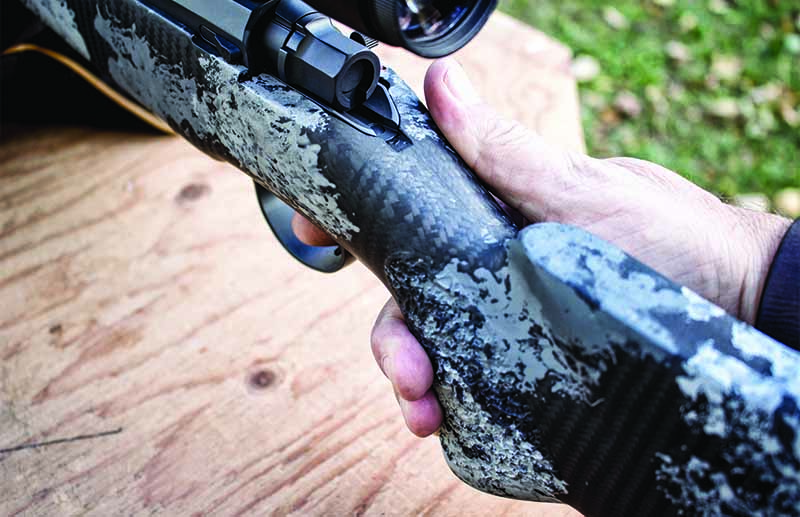
“So, you now ask why are you known for your synthetic stocked rifles?” continued Bansner. “I love what I do, but you also have to generate enough money to survive or you won’t be in business long. The market was moving toward synthetic stocks in the late ’70s early ’80s. Fiberglass was the first material to be formed into rifle stocks. Why? Number one was weight, then because it was impervious to weather conditions. They also had a reputation as being ugly. I changed all that and built them with the same attention to detail as I did with my wood stocks. High-quality fit and finish, along with great accuracy, gave us a super high-quality synthetic rifle. Oh, and I could build five to six of these in the time it took to build one wood-stocked rifle.”
The insight and wisdom from these three guys make a clear case for a proper-fitting stock. I’ve had both Sells and Bansner create custom stocks for me, and those guns are without a doubt my favorites. There are some affordable factory rifles that can be customized to better fit your frame—the Savage AccuStock coming quickly to mind—but I think being properly measured for a stock might shed some light on your proper dimensions. One well-fitting stock might change your entire shooting experience.
Editor's Note: This article originally appeared in the December 2020 issue of Gun Digest the Magazine.

Next Step: Get your FREE Printable Target Pack
Enhance your shooting precision with our 62 MOA Targets, perfect for rifles and handguns. Crafted in collaboration with Storm Tactical for accuracy and versatility.
Subscribe to the Gun Digest email newsletter and get your downloadable target pack sent straight to your inbox. Stay updated with the latest firearms info in the industry.

![Best Concealed Carry Guns In 2025 [Field Tested] Wilson Combat EDC X9S 1](https://gundigest.com/wp-content/uploads/Wilson-Combat-EDC-X9S-1-324x160.jpg)


![Best 9mm Carbine: Affordable PCCs [Tested] Ruger Carbine Shooting](https://gundigest.com/wp-content/uploads/Ruger-Carbine-Shooting-100x70.jpg)
![Best AR-15: Top Options Available Today [Field Tested] Harrington and Richardson PSA XM177E2 feature](https://gundigest.com/wp-content/uploads/Harrington-and-Richardson-PSA-XM177E2-feature-100x70.jpg)
